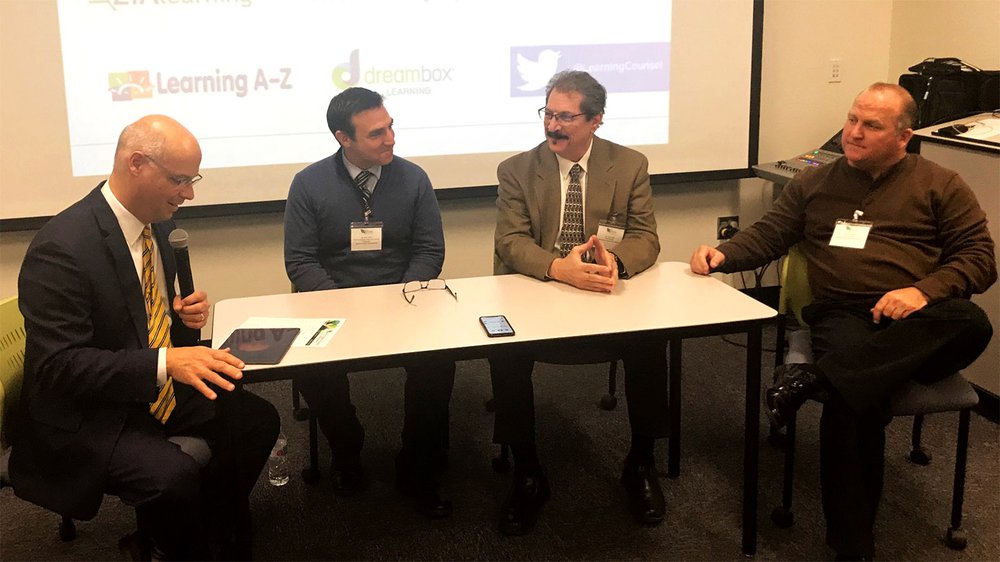If you are new to the Learning Counsel, we are a research institute and news media hub, focused on providing context for the shift in education to digital curriculum. The membership is made up of 215,000 Superintendents, tech and instructional administrators, curriculum specialists, thousands of publishers, and interested enthusiasts anywhere in the teaching and learning field.
The Learning Counsel produces thirty Digital Curriculum Discussions each year across the U.S., bringing in district experts to share their expertise around the digital transition in the school world. At a recent event in Phoenix, the Learning Counsel’s David Kafitz led an impactful discussion on the challenges that districts face to maintain focus on learner success in the wake of a technology maelstrom.
David Stong is a Board Member at Greater Arizona Educational Leadership. He believes it is important to look past the analytics and see the student behind the numbers. Nick Trakas, the Director of Technology and Curricular Innovation at Florence Unified School District agreed. He said that students learn in very different ways, and it is important “To see that we can design our learning paths to be more specific to each type of student instead of a single path – if we can put our learning paths together to allow students to learn in the best way that suites them, we are only going to be more successful moving forward.”
Eric Godfrey is the Superintendent at Buckeye Union High School District. According to Godfrey, “The pendulum of assessment has swung to one side, and everyone is frustrated about how much testing we do. But what exactly are we measuring?” Godfrey’s district is asking the tough questions. “Are we measuring the things that matter? To take a standardized test at a state level, does that really inform instruction? That’s only changing instruction from a year-to-year basis. If we’re measuring and changing instruction and sometimes changing instruction patterns within the period, we get better. The more that we can measure important things and make adjustments to those things creates the opportunity for personalizations. Godfrey wants to get the pendulum from parents and the law-makers to swing back and give educators opportunities for autonomy. “We can make choices to create learning opportunities. To not be so focused on scores will allow us to have creativity back in the classroom and allow teachers to have opportunities to be able to create the lessons that will allow for us to prepare kids for what’s next.”
“We’ve had digital devices in our schools since 2009, but just having devices doesn’t make for digital learners,” said Trakas. “We have instructional coaches at our schools. These are the ones that work with our teachers individually. As they become more comfortable with how to integrate technology in their classrooms, they can best change what’s happening in those classrooms. We’re moving away from the stand and deliver approach – more into project-based learning, more to meeting the ISTE Standards. It’s getting the help that our teachers need and doing that though our instructional coaches. We’re making time for our teachers so they can have those PLC groups or cluster meetings so they can get together and collaboratively work on what works best for the students in the classroom.” Trakas said the ideas from collaboration are really making a difference. Next year, they are planning to have teachers in their K-8 schools take a half day every Wednesday just for professional development.
Stong, who is also on the board of a charter school, says that most schools have a very frenetic atmosphere. “It’s difficult to introduce new technologies, new modalities in a very frenetic environment,” said Stong. “We are looking at doing this in ways that don’t add on more work for a teacher. We want to be more constructive in what we’re doing. That’s a difficult transition. You have teachers in the pipeline that don’t have the training. How are they now going to take on new technology? You need to give them time to do that. You need to have technologists in the school. You need some one who can set up and integrate, but you also have to have someone who can teach, because those are two different types of people.”
Please watch the video below. There is so much more to take from the discussion. You’ll find a number of takeaways for your own school or district – things that you can implement today that will make a difference for your learners tomorrow.











